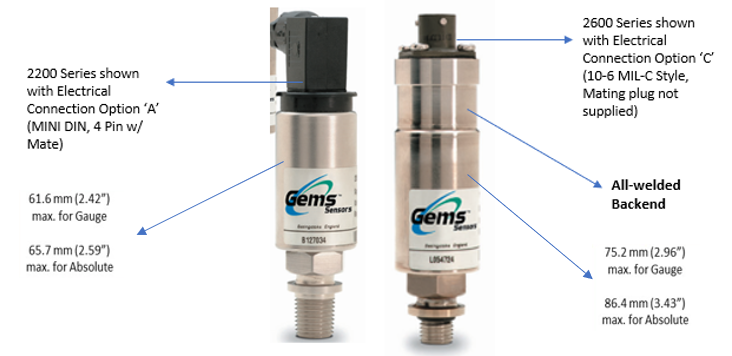Internally, the 2200 and 2600 series share the same electronics and pressure sensing technologies. The main difference between the two series is the physical housings:
- The 2200 is more compact and has a limited electrical connection options
- The 2600 is slightly larger, has an All-Welded Backend and has more robust electrical connection options
To start, there are physical differences

With the 2200 series pressure sensor, your electrical connection options are:
A - 4 PIN DIN (Micro) Mating Connector Supplied (aka Mini-DIN) (IP65)
B - 4 PIN DIN (Micro) Mating Connector Not Supplied (aka Mini-DIN) (IP65)
2 – Cable, NEMA 4, USA Color Code wiring (IP65)
D – Cable, European Color Code wiring (IP65)
F - Cable Gland, Metal (IP67)
With the 2600 series pressure sensor, your electrical connection options are:
C - Fixed Plug, Size 10-6, Mating Plug Not Supplied, aka MIL-C (IP65)
G - Fixed Plug, DIN 43650, Mating Plug Supplied, aka Large DIN (IP65)
M - Molded Cable, Immersible (IP68)
1 - Fixed Plug, Size 8-4, Mating Plug Not Supplied (IP65)
3 - Conduit Connector, ½” NPT Ext., 1M Cable (IP65)
So, the decision to select a 2200 series pressure sensor versus a 2600 series pressure sensor comes down to which electrical connection is required for your application:
- If you need a simple, quick disconnect option and the application does not require an environment rating of higher than IP65, then choose the 2200 series pressure sensor with the Mini-DIN electrical option (IP65, A or B).
- If you need higher environment protection, then choose the 2200 with the Metal Cable Gland option (IP67, F).
- If you need to submerse your sensor into a tank of fluids, then select the 2600 series pressure sensor with the Immersible option (IP68, M).
